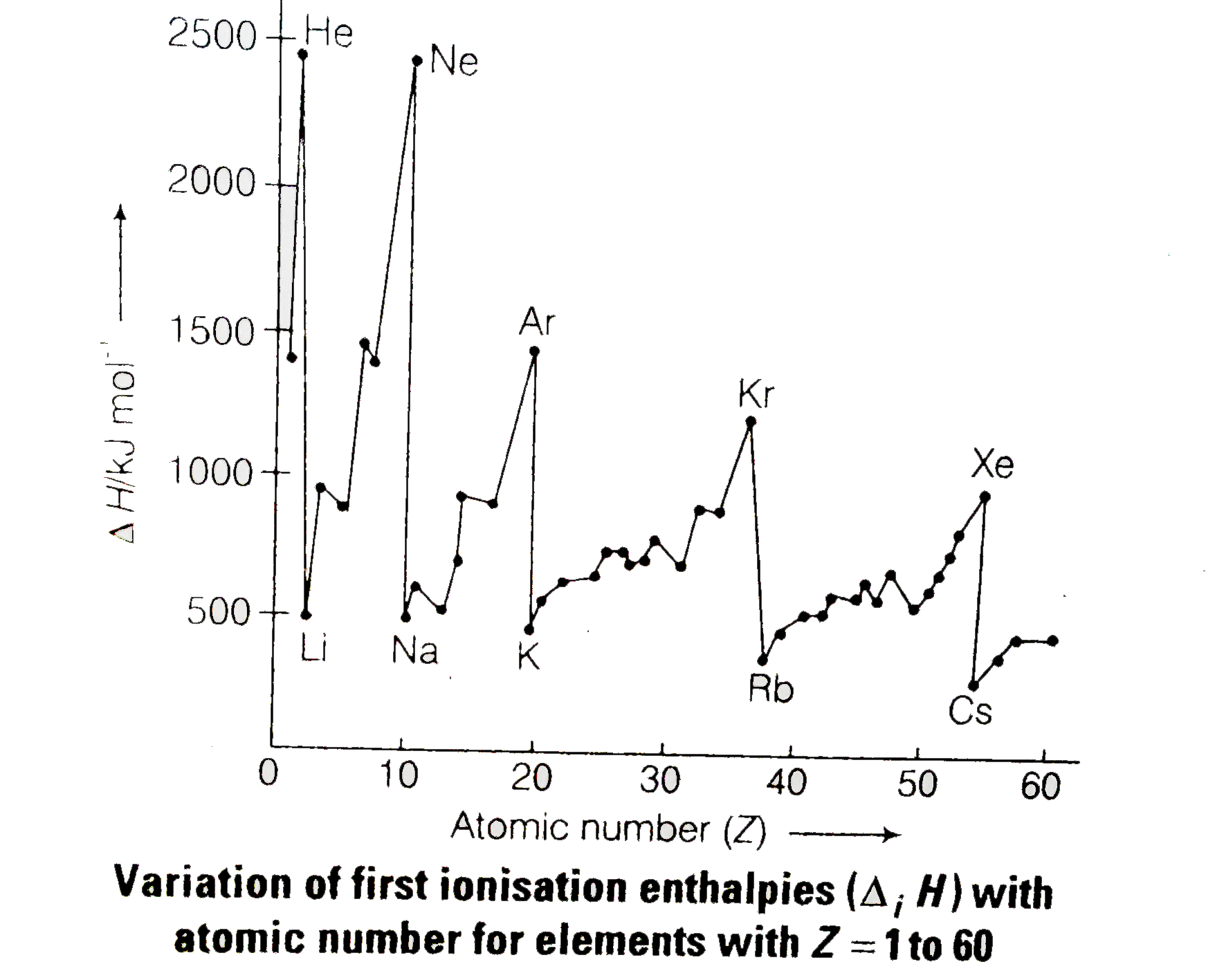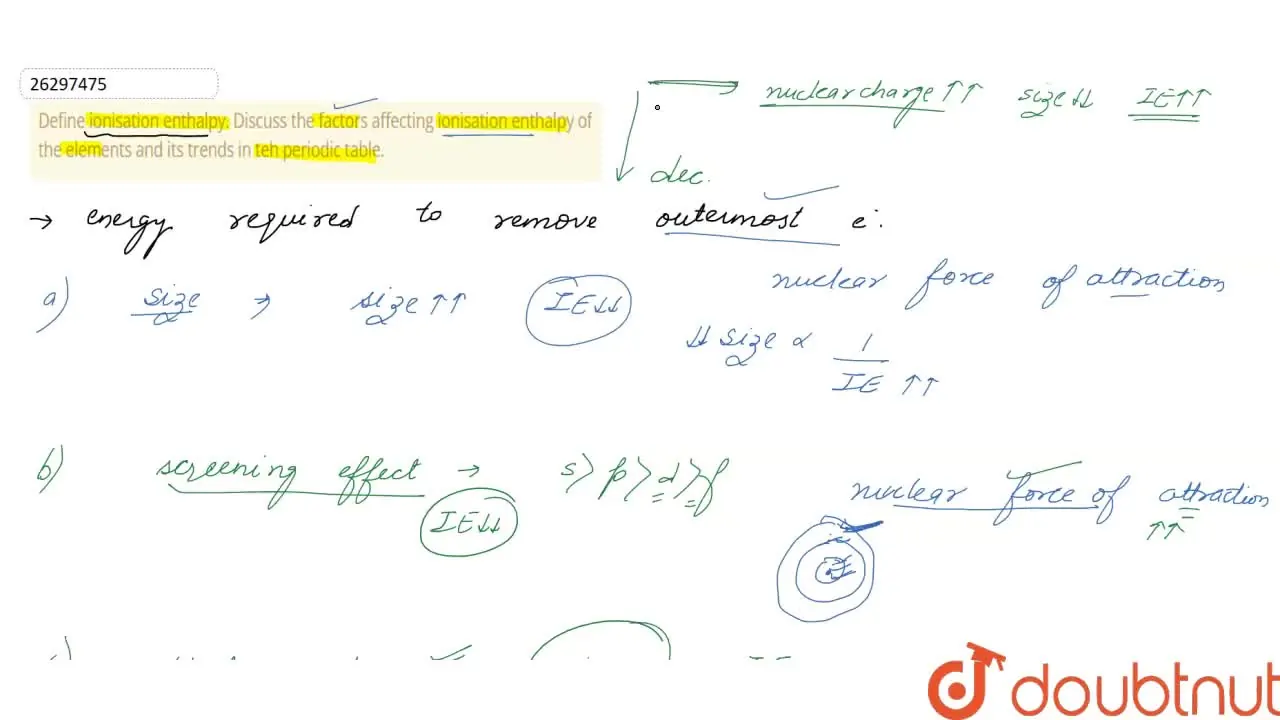Define ionisation enthalpy. Discuss the factors affecting ionisation enthalpy of the elements and its trends in teh periodic table.
The correct Answer is:A
Ionisation enthalpy The minimum amount of energy required to remove the most loosely bound electron from an isolated gaseous atom so as to convert it into a gaseous cation is called its ionisation enthalpy. It is represented by ΔiH.
Factors affectingn ionsation enthalpy of the elements.
Ionisation enthlpy depends upon the following factors.
i) Nuclear charge the ionisation enthalpy increases with increase in nuclear charge. This is due to the fact that with increase in nuclear charge, the electrons of the outer shell are more firmly held by the nucleus and thus greater energy is required to pull out and electron from the atom.
e.g. the ionisation enthalpy increases as we move along a period from left to right due to increased nuclear charge.

ii) Atomic size or radius: Ionisation enthalpy decreases as the atomic size increases. As the distance of the outer electrons from the nucleus increases with increases in atomic radius, the attractive force on the outer electron decreases.
As a result, outer electrons are held lesss firmly and hence lesser amount of enery is required to knock them out. thus, ionisation enthalpy decreases with increase in atomic size. Ionisation enthalpy is found to decrease on moving down a group.

iii) Penetration effect of the electrons: Ionisation enthalpy increases as the penetratioin effect of the electrons increases. It is well known fact that in case of multielectron atoms. the electrons of the s-orbital has the maximum probability of bieng found near the nucleus and this probability goes on decreasing in case of p, d and f-orbitals of the same shell.
In other words, s-electrons of any shell are more penetrating towards the nucleus than p-electron the same shell. Thus, when the same shell, the penetration effect decreases in the order s>p>d>f.
e.g. First ionisation enthalpy of aluminium is lower than that of magnesium. This is due to the fact that in case of aluminium (1s22s22p63s23p1x), we have to pull out a p-electron to form Al+ ion whereas in case of magnesium (1s22s22p63s2) we have to remove an s-electron of hte same energy shell to produce Mg+ ion.
v) Shielding or screening effect of inner shell electrons: As the shielding or the screening effect of the inner electrons increases, the ionisation enthalpy decreases. Consequently, the force of attraction by the nucleus for the valence shell electrons decreases and hence the ionisation enthalpy decreases.
Effect of arrangement of electrons: If an atom contains exactly half filled or completely filled orbitals then such an arrangement has extra stability, the removal of an electron from such an atom requires more energy than expected.
e.g. Be (1s22s2) has higher ionisationi enthalpy than B (1s22s22p1) and N(1s22s22p6x2p1y2p1z) has higher ionisation enthalpy than O (1s22s22p2x2p1y2p1z). In general, as we move from left to right in a period, the ionisation enthalpy increases with increasing atomic numbers.
The ionisation enthalpies keep on decreasing regularly as we move down a group from one element to the other.

Related Playlists
- BOOK - NCERT EXEMPLARCHAPTER - CLASSIFICATION OF ELEMENTS AND PERIODICITY IN PROPERTIES.EXERCISE - Assertion and Reason3videos
CLASSIFICATION OF ELEMENTS AND PERIODICITY IN PROPERTIES.
- BOOK - NCERT EXEMPLARCHAPTER - CHEMICAL BONDING AND MOLECULAR STRUCTUREEXERCISE - Long Answer type questions9videos
CHEMICAL BONDING AND MOLECULAR STRUCTURE
- BOOK - NCERT EXEMPLARCHAPTER - ENVIRONMENTAL CHEMISTRYEXERCISE - Long Answer Type5videos
ENVIRONMENTAL CHEMISTRY
Similar Questions
Discuss the factors affecting electron gain enthalpy and the trend in its variation in the periodic table.
View SolutionThe second ionisation enthalpy is
View SolutionThe first ionisation enthalpy of the elements C,N,P,Si are in the order of
View SolutionCorrect order of ionisation enthalpy is
View SolutionIonisation enthalpy of Na would be same as
View SolutionThe second ionisation enthalpy of an element M is the energy required to
View SolutionThe ionisation enthalpy of alkaline earth metals is
View SolutionPeriodicity In Ionisation Enthalpy
View SolutionSelect whether the statement is true or false .Helium has the highest ionisation enthalpy.
View SolutionWhy second ionization enthalpy is always higher than the first ionisation enthalpy for every element?
View Solution


